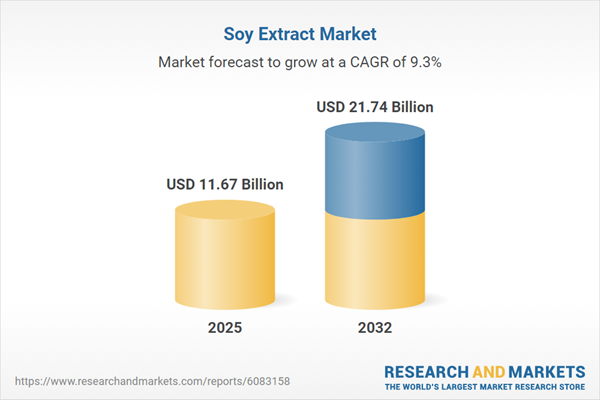Speak directly to the analyst to clarify any post sales queries you may have.
Soy extract is reshaping ingredient innovation, giving senior decision-makers impactful tools to meet growing demands for plant-based, health-focused, and sustainable solutions. With broad application potential and proven benefits, soy extract positions portfolios for differentiation and future growth.
Market Snapshot: Soy Extract Market Size and Growth
The soy extract market progressed from USD 10.67 billion in 2024 to USD 11.67 billion in 2025 and is forecast to reach USD 21.74 billion by 2032, reflecting a 9.30% CAGR. Growth is driven by the industry’s robust shift toward clean-label and bioactive ingredients, with substantial traction across food, beverage, personal care, and pharmaceutical applications. Global adoption is accelerating, supported by the rising demand for plant-based proteins and wellness-orientated product design strategies in established and emerging markets. As a result, soy extract is uniquely positioned for integration within B2B innovation pipelines.
Scope & Comprehensive Segmentation
- Product Types: Includes soy isoflavones—daidzein, genistein, glycitein—soy lecithin, soy protein in both concentrate and isolate forms, and soy saponins. Each offers distinct functionality for health, nutrition, and industrial applications.
- Forms: Available as liquid solutions and suspensions, dry powder formats for easy blending, and standardized tablets for consistent supplementation and pharmaceutical use.
- Distribution Channels: Distributed via pharmacies, physical retail stores, specialty outlets, direct-to-consumer websites, and prominent e-commerce platforms, reinforcing accessibility in diverse commercial contexts.
- Applications: Deployed in cosmetics and personal care for targeted formulations across hair, oral, and skin care. Integral to dietary supplements—capsules, powders, softgels, and tablets—as well as functional foods and beverages spanning bakery, dairy, snacks, and drinks. Utilized in a range of pharmaceutical products focused on health and wellness objectives.
- End Users: Serves cosmetic manufacturers, food and beverage producers with expertise in bakery, beverage, and dairy, pharmaceutical companies, and leading retailers in both offline and online channels.
- Regions Covered: Scope spans the Americas, including North and Latin America, Europe, Middle East, Africa, and Asia-Pacific. Regional granularity enables targeted strategies tailored to major countries within each territory, optimizing growth and compliance initiatives.
- Key Companies Profiled: Features major players such as Archer Daniels Midland Company, Cargill, International Flavors & Fragrances, Kerry Group, Ingredion, Tate & Lyle, Roquette Frères, Bunge, Fuji Oil, and Sternchemie, each delivering broad-scale supply capabilities.
Soy Extract: Key Takeaways for Senior Leaders
- Natural, plant-based components are critical for businesses seeking alignment with global wellness and sustainability preferences, elevating product appeal in nutrition and personal care domains.
- Advanced extraction technologies like green solvents and enzymatic processes are making soy-based ingredients more functional and environmentally sustainable, supporting regulatory and end-user requirements.
- Shifting regulatory norms and new tariffs are prompting a focus on localized sourcing and flexible supplier networks, enabling better risk mitigation and operational agility.
- Partnerships between raw material producers and brand owners accelerate product development, ensuring more rapid adaptation to emerging consumer preferences.
- Commitment to clean-label and organic certification underpins soy extract’s value, appealing to both product developers and end consumers concerned with ingredient transparency.
- Integration of digital traceability and robust supply chain analytics fortifies organizational resilience, providing greater oversight and responsiveness in dynamic markets.
Tariff Impact: Navigating Trade Disruptions
Upcoming tariffs on soy-derived ingredients in the United States will reshape sourcing and pricing dynamics. Producers are responding by expanding domestic capacity, securing alternative suppliers, and renegotiating contracts to buffer price and supply volatility. Businesses that prioritize flexible procurement strategies and proactive risk management will adapt more effectively to changing trade environments and ensure continued access to quality soy extract.
Methodology & Data Sources
This analysis is based on direct interviews with key value chain stakeholders, including suppliers and distributors, and is enriched by secondary research from industry publications, patent filings, and regulatory guidelines. Expert cross-validation ensures reliable market insights and strategic relevance.
Why This Report Matters to Industry Decision-Makers
- Supports benchmarking across diverse soy extract applications, segments, and regions, empowering data-driven strategic planning and prioritization.
- Delivers timely guidance on supply chain risk mitigation and regulatory adaptation, helping reinforce agility and operational resilience.
- Provides actionable intelligence and clear trend analysis, activating effective product innovation and targeted supplier partnerships in competitive B2B markets.
Conclusion
Soy extract remains a pivotal lever for innovation in food, nutrition, and industrial solutions. Applying the insights here can help industry leaders address complexity, navigate regulatory shifts, and secure a distinct competitive advantage.
Table of Contents
3. Executive Summary
4. Market Overview
7. Cumulative Impact of Artificial Intelligence 2025
Companies Mentioned
The companies profiled in this Soy Extract market report include:- Archer Daniels Midland Company
- Cargill, Incorporated
- International Flavors & Fragrances Inc.
- Kerry Group PLC
- Ingredion Incorporated
- Tate & Lyle PLC
- Roquette Frères
- Bunge Limited
- Fuji Oil Co., Ltd.
- Sternchemie GmbH
Table Information
| Report Attribute | Details |
|---|---|
| No. of Pages | 193 |
| Published | November 2025 |
| Forecast Period | 2025 - 2032 |
| Estimated Market Value ( USD | $ 11.67 Billion |
| Forecasted Market Value ( USD | $ 21.74 Billion |
| Compound Annual Growth Rate | 9.3% |
| Regions Covered | Global |
| No. of Companies Mentioned | 11 |









